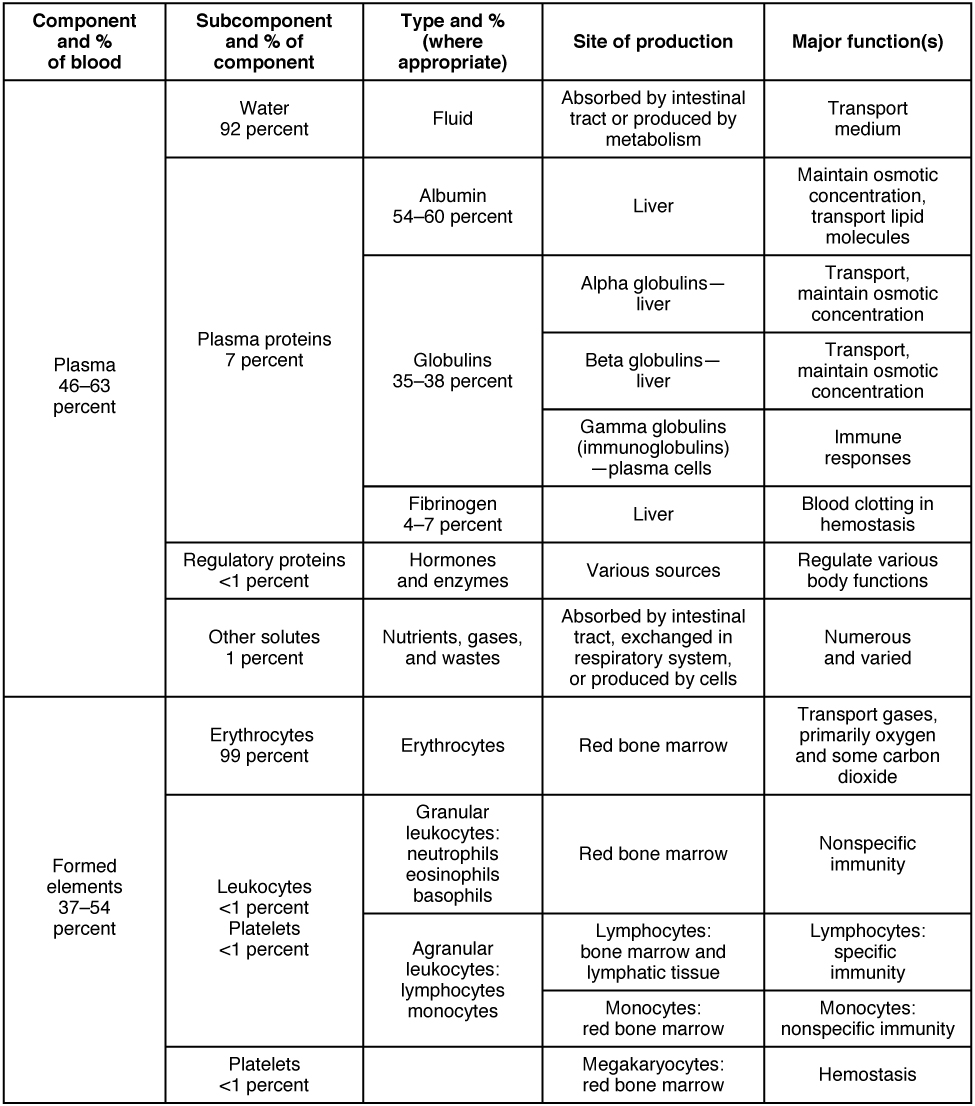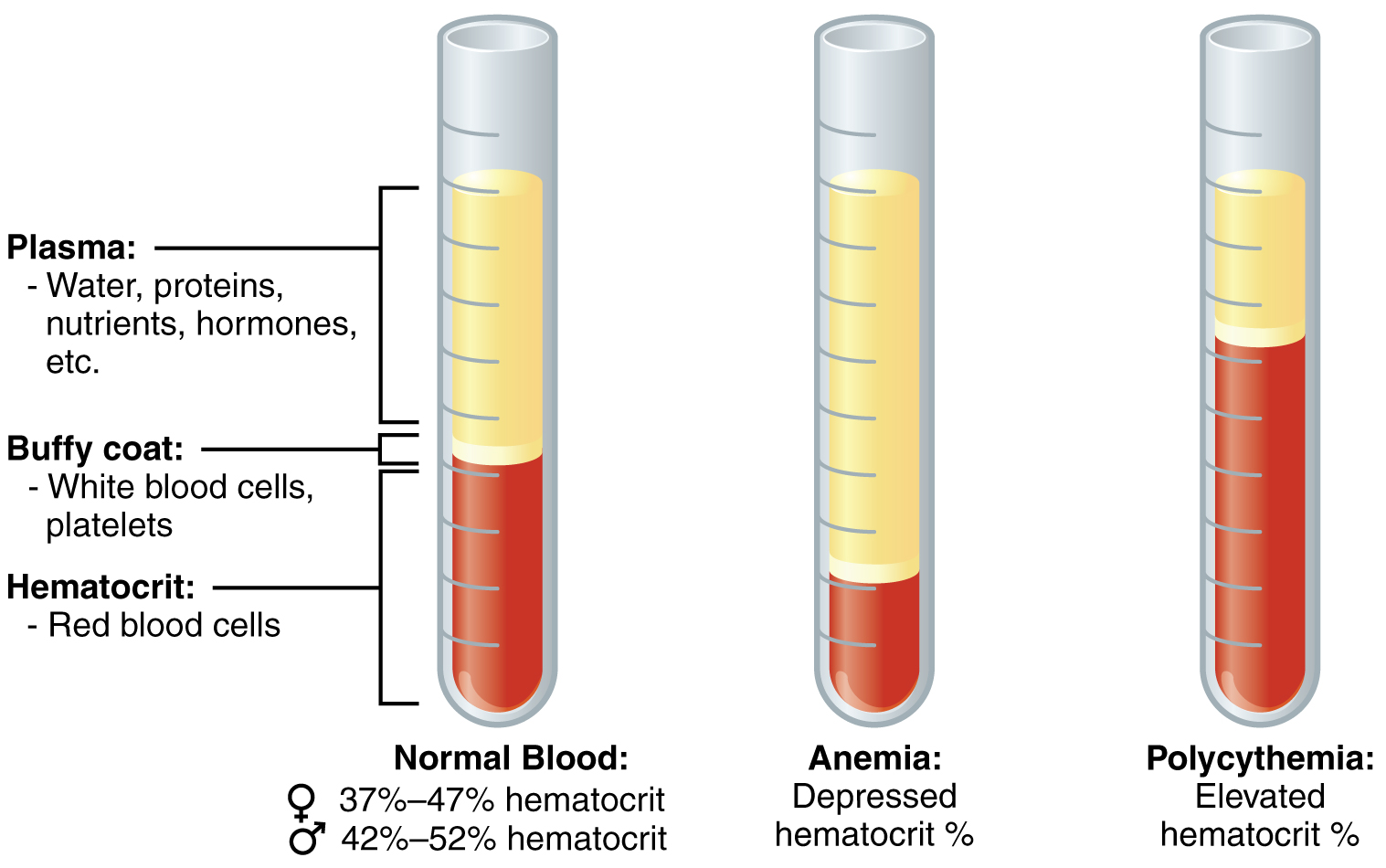42 Blood
Learning Objectives
After reading this section you should be able to-
- Describe the general composition of blood (e.g., plasma, formed elements).
- Describe the composition of blood plasma.
- List the major types of plasma proteins, their functions, and sites of production.
- Compare and contrast the morphological features and general functions of the formed elements (i.e., erythrocytes, leukocytes, platelets).
- List the five types of leukocytes in order of their relative prevalence in normal blood, and describe their major functions.
- Describe the structure and function of hemoglobin, including its breakdown products.
- Define hematocrit and state the normal ranges for adult males and females.
General Composition of Blood
Blood is a connective tissue consisting of cellular elements and an extracellular matrix. The cellular elements—referred to as the formed elements—include red blood cells (RBCs), white blood cells (WBCs), and cell fragments called platelets. The extracellular matrix, known as plasma, makes blood unique among connective tissues because it is fluid. This fluid, which is mostly water, suspends the formed elements and enables them to circulate throughout the body within the cardiovascular system.
Functions of Blood
Blood’s primary functions include transportation, defense, and maintenance of homeostasis.
Transportation
Nutrients from the foods you eat are absorbed in the digestive tract and travel in the bloodstream to the liver for processing before delivery to body cells. Oxygen from the air you breathe diffuses into the blood in the lungs and is then pumped by the heart to the rest of the body. Endocrine glands release hormones into the bloodstream, which carries them to target cells. Blood also picks up cellular wastes, transporting carbon dioxide to the lungs for exhalation and other wastes to the kidneys and liver for excretion.
Defense
WBCs in the blood protect the body from external threats like bacteria and viruses. They also target internal threats such as cancer cells. Platelets and plasma proteins interact to create clots, preventing further blood loss from injuries.
Maintenance of Homeostasis
Blood helps regulate body temperature through vasodilation and vasoconstriction, which direct blood flow to the skin or core. It also maintains chemical balance through buffers that regulate pH and proteins that exert osmotic pressure, ensuring proper water content in cells.
Composition of Blood
Blood is composed of plasma and formed elements (Figure 41.1).

Plasma
Plasma is about 92% water and contains proteins, electrolytes, gases, nutrients, and waste products. Plasma proteins, which constitute about 7% of plasma, include albumin, globulins, and fibrinogen.
- Albumin: The most abundant plasma protein, produced by the liver. Albumin maintains osmotic pressure and transports fatty acids and steroid hormones.
- Globulins: There are three types of globulins—alpha, beta, and gamma. Alpha and beta globulins, produced in the liver, transport iron, lipids, and fat-soluble vitamins. Gamma globulins (antibodies), produced by plasma cells, are involved in immune responses.
- Fibrinogen: The least abundant plasma protein, produced by the liver. Fibrinogen is essential for blood clotting.
In addition to proteins, plasma contains various electrolytes (e.g., sodium, potassium, calcium), dissolved gases (e.g., oxygen, carbon dioxide), nutrients (e.g., glucose, amino acids), and waste products (e.g., urea, bilirubin).
Formed Elements
The formed elements of blood include erythrocytes, leukocytes, and platelets.
Erythrocytes (Red Blood Cells)
Erythrocytes are the most common formed elements in blood. Males typically have about 5.4 million erythrocytes per microliter (µL) of blood, and females have about 4.8 million per µL. Erythrocytes are biconcave discs without a nucleus, optimizing them for gas exchange. Their primary function is to transport oxygen from the lungs to tissues and carbon dioxide from tissues to the lungs.
Hemoglobin and hematocrit
Hemoglobin, found in RBCs, is composed of four polypeptide chains, each with a heme group containing iron that binds oxygen. Hemoglobin carries oxygen to tissues and returns carbon dioxide to the lungs. When RBCs are broken down, hemoglobin is degraded into bilirubin (excreted in bile) and iron (recycled). Hematocrit measures the percentage of RBCs in blood (Figure 41.2). Normal ranges are 37-47% for females and 42-52% for males. The measurement is performed by spinning a blood sample in a centrifuge, which separates the heavier RBCs from the plasma.

Leukocytes (White Blood Cells)
Leukocytes are larger than erythrocytes and possess a nucleus. They are less numerous, with typical counts ranging from 5000 to 10,000 per µL. Leukocytes are categorized into two main types: granular and agranular.
Granular Leukocytes
- Neutrophils: Comprising 50-70% of WBCs, neutrophils are rapid responders to infection and are efficient phagocytes, particularly targeting bacteria. Their granules contain lysosomal and other antimicrobial agents.
- Eosinophils: Making up 2-4% of WBCs, eosinophils combat parasitic infections and allergic reactions. They contain granules with antihistamines and toxic proteins for parasites.
- Basophils: The least common, accounting for less than 1% of WBCs. Basophils release histamines and heparin, intensifying the inflammatory response.
Agranular Leukocytes
- Lymphocytes: Representing 20-30% of WBCs, lymphocytes are crucial for the immune response. There are three types:
- B cells: Produce antibodies.
- T cells: Attack infected or cancerous cells.
- Natural Killer (NK) cells: Destroy abnormal cells.
- Monocytes: Making up 2-8% of WBCs, monocytes differentiate into macrophages that phagocytize pathogens and debris. They also release chemicals that attract other leukocytes to infection sites.
Platelets
Platelets, also known as thrombocytes, are small cell fragments derived from megakaryocytes. There are typically 150,000-160,000 platelets per µL of blood. Platelets are essential for blood clotting and wound repair. They have a lifespan of about 10 days and are involved in hemostasis by forming platelet plugs and releasing chemicals necessary for clotting.
Adapted from Anatomy & Physiology by Lindsay M. Biga et al, shared under a Creative Commons Attribution-ShareAlike 4.0 International License, chapter 18
Connective tissue made up of cellular elements and an extracellular matrix
iron-containing protein in red blood cells that facilitates oxygen transportation
the portion of blood made up of red blood cells, measured in percentage
white blood cells

